Nieuwe alinea
Simultaneously operating the F-16 and F-35, the Royal Danish Air Force or Flyvevåpnet is currently in the process of modernizing its hardware while facing some challenges to keep up with their operational tasks.
Text and photos: Emiel Sloot

Fighter Wing Skrydstrup
Located in the southern part of Jutland, the Fighter Wing Skrydstrup is responsible for all Danish fighter operations. Currently still relying on the F-16, replacement by the 5th generation F-35 has already commenced, and is expected to be completed by 2027. The Fighter Wing’s main task is air policing and defence for the country. Now that Sweden has joined NATO in 2024, Denmark is fully surrounded by alliance members. Nevertheless, its airspace can still be breached by air traffic approaching over international seas. Not only that, in geographic terms the country literally forms the doorway between the North and Baltic Seas. To cope any airborne threat, the Fighter Wing Skrydstrup maintains a 24/7 Quick Reaction Alert (QRA) with a pair of F-16s, operating under the callsign ‘Moon Beam.’ Airspace surveillance is carried out by the Air Control Wing located at Karup, an air base in central Jutland. Four airspace surveillance radars located throughout the country and on the island of Bornholm in the Baltic Sea are used to create a complete picture of airborne activities.
Beside its national defence responsibilities, the Fighter Wing has also been active abroad in various international operations for the last decades. Furthermore, it frequently deploys to Greenland which, together with the Faroe Islands, are both autonomous territories within the Kingdom of Denmark.
The F-16’s days are now numbered, yet the Fighter Wing is currently employed with the conversion training of Ukrainian pilots in preparation for the arrival of F-16s for the Ukrainian Forces. Denmark has committed to donate a number of these, while the rest of the fleet has recently been sold to Argentina, with deliveries expected in a few years. From then on, F-35s will take over the roles.
Want to know more about the history of the Danish Panthers and Vipers, Fighter Wing Skrydstrup and its unis, and when the air base was established? Then continue reading below, as we go a bit more into detail.
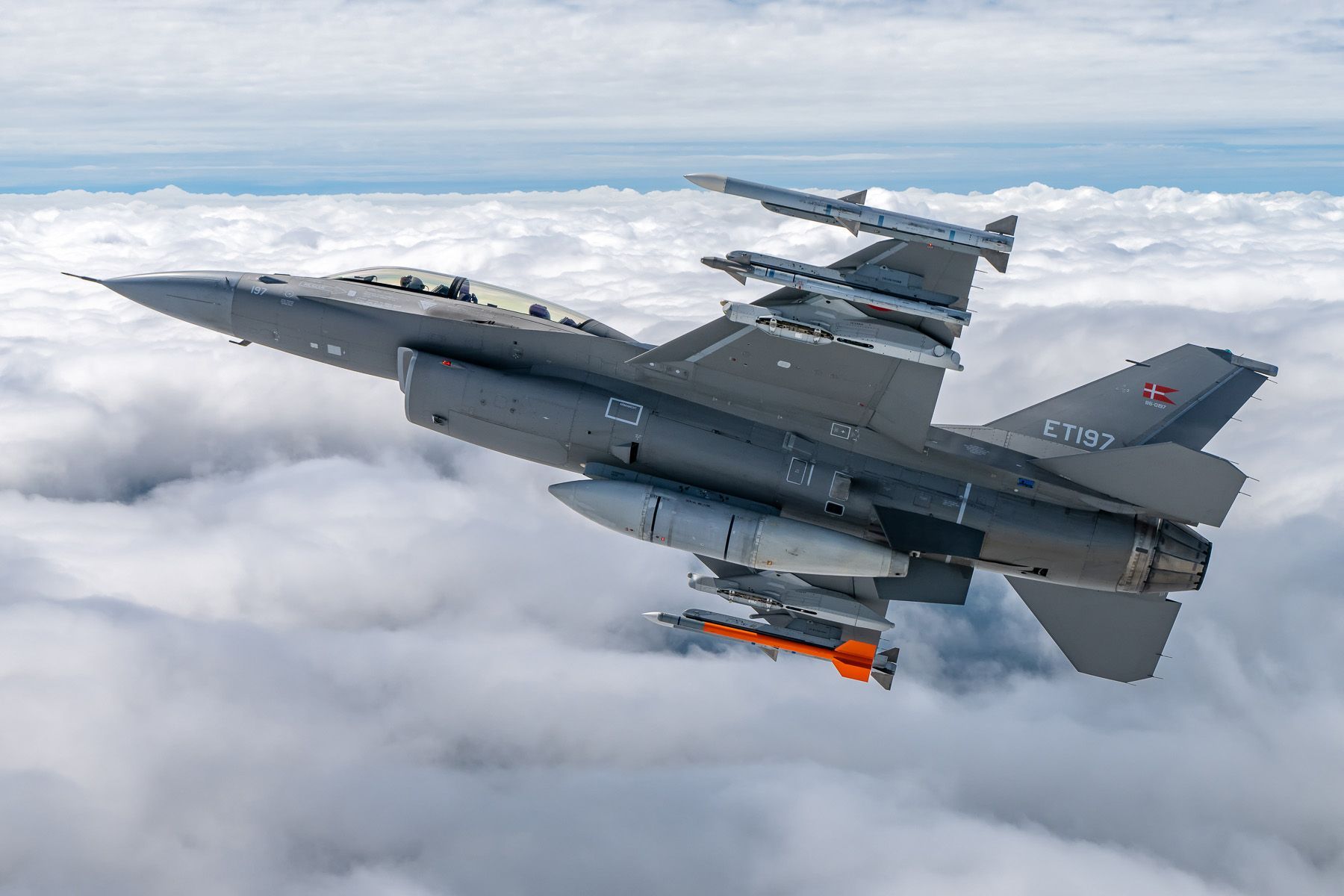
F-35
The Lockheed-Martin F-35 Lightning II is becoming a key element in several air arms worldwide, and Denmark is no exception. Actually, all four first-hour European F-16 operators introducing this fighter in the late 1970s have chosen the Panther – the unofficial F-35 nickname – for its replacement.
Already in 2002, Denmark joined the Joint Strike Fighter (JSF) programme as a so-called Level 3 partner. Three different programme partner levels indicate amongst others the amount of investments into the programme and the number of subcontracts open for bids for the national industry, with Level 3 being the lowest.
Although joining in an early stage, still it would take considerable time to actually select an F-16 replacement. Alternatives such as the Saab JAS 39 Gripen NG and the Boeing F/A-18E/F Super Hornet were also considered in the first decade of this century. The Eurofighter was also on the table, but its consortium withdrew from the competition in 2007. Then, in 2010, the whole project was put on hold due to the dire economic situation. Nevertheless, the air force did station an F-16BM (serialled ET-210) at Edwards AFB, California that same year, in support of flight testing for the F-35 programme. Danish test pilot LtCol Casper Børge Nielsen formed part of this test flight.
Three years later, the Danes decided to reopen the competition, although the number of aircraft to be procured was reduced from 48 to 30. Eurofighter was successfully re-invited to join, and on 13 March 2013, the selection process officially kicked off again.
Following the evaluation of the Eurofighter, Super Hornet and Lightning II, the Danish defence committee announced on 11 May 2016 that it had selected the latter, in a planned purchase of 27 F-35As for US 3 billion (DKK 20 billion), slightly less than the 30 it originally looked for. Boeing, that had offered the F/A-18E/F Super Hornet, indicated that they would take legal action against this decision as they mentioned that some data used was flawed. Eventually, this was overruled in court as “the authorities' decisions on refusal of access to the documents are legal and valid." The planned acquisition was approved by the Danish parliament in 2017.
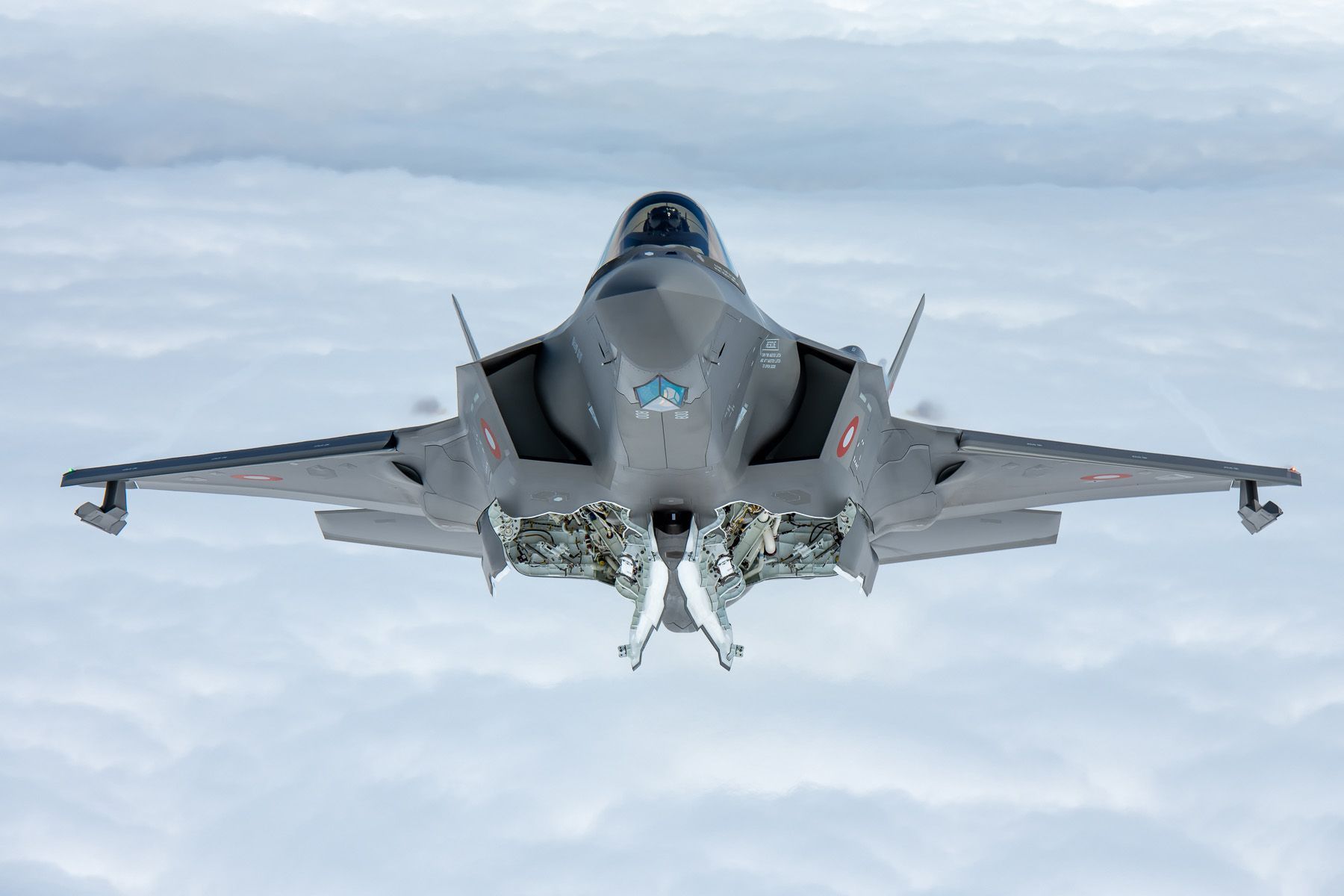
In January 2020, Lockheed Martin announced that assembly had begun on the first Danish F-35A, serialled L-001 with c/n AP-01. Rolling out on 13 January 2021, its first flight from the Fort Worth, Texas assembly facility took place on 8 March 2021. Soon after, the first two were delivered to Luke AFB, Arizona on 13 April 2021, to join the 308th Fighter Squadron. This unit was reactivated on 30 November 2018 as part of the 56th Fighter Wing, as a joint F-35 training unit for the air forces of Denmark, the Netherlands and the United States. The latter two air arms had already assigned some aircraft to the 308th FS in an earlier stage. Two more Danish F-35s joined on 12 May 2021 and a third pair entered service in June 2021.
Following the establishment of the training centre at Luke AFB, it was time to equip the operational squadron back home. As part of the Fighter Wing Skrydstrup, Fighter Squadron 727 had been appointed to become the sole F-35 unit within the Royal Danish Air Force (more info on this and other squadrons is mentioned separately, further below). The first four F-35As were ferried via Lajes, Azores and arrived at Skrydstrup on 14 September 2023. An official arrival ceremony was held on 1 October, the anniversary day of the Flyvevåpnet.
Currently, the F-35 programme is encountering a setback involving the Technology Refresh 3 (TR-3) hardware and software update. This issue is affecting operators worldwide, Denmark more than others since it only has taken delivery of a limited number of aircraft so far, all with TR-2 standard.
The TR-3 configuration is designed to enable modernized Block 4 capabilities for the F-35; Block 4 is expected to feature a range of significant system upgrades, including an improved radar system, upgraded electronic warfare capabilities, and a new set of long-range precision weapons. TR-3 will incorporate a new core processor and a new cockpit display. Data storage and processing will be improved for better pilot-user interfaces. When released, TR-3 will also be available to update the current TR-2 aircraft.
Flight testing of TR-3 started in January 2023, but since then, several issues have been encountered and Lockheed Martin has been struggling to solve these. While opting for interim solutions to at least clear the TR3 aircraft for flying, operators are reported to be reluctant to accept this temporary fix. At this stage (mid 2024), TR-3 is not expected to be cleared for use by late 2024.
Meanwhile, all F-35s that were already built with TR-3 configuration are stored at the various assembly facilities, awaiting the certification and clearance. In view of Denmark, aircraft L-011 to L-016 have already been completed and test-flown by July 2024, but are parked at Fort Worth pending delivery.
In order to have sufficient airframes available at home, the Royal Danish Air Force decided in June 2024 to transfer the six dedicated training aircraft (L-001 to L-006) from Luke AFB to Skrydstrup. Denmark’s training partners within the 308th FS should have enough aircraft remaining to ensure continuation of crew conversion. The move would be temporarily anyway.
Some controversy has popped up recently, as apparently Denmark did not acquire any new advanced weaponry for the F-35, but rather relying on older systems in use with the F-16. This would mean that the full potential of the 5th generation fighter remains unlocked, thus providing limited value for future NATO operations if this issue will not be fixed in due time.
Delivery of the 27th and last F-35A is still planned for 2027.
F-35 serial overview
- L-001/004 F-35A c/n AP-01/04 FMS 19-5530/5533
- L-005/010 F-35A c/n AP-05/10 FMS 20-5645/5650
- L-011/016 F-35A c/n AP-11/16 FMS 22-5739/5744
- L-017/027 F-35A c/n AP-17/27 FMS 2x-5xxx/xxxx
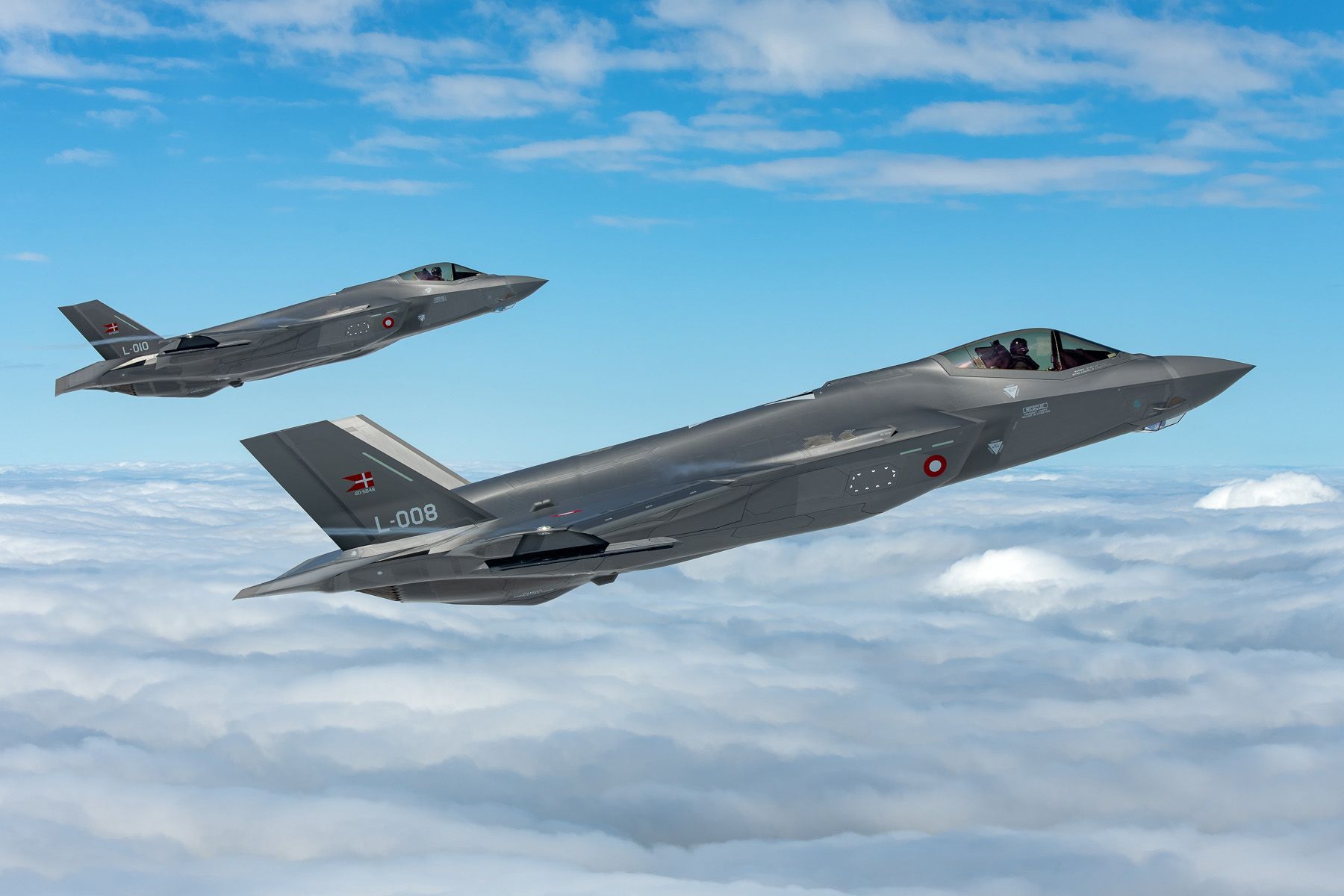
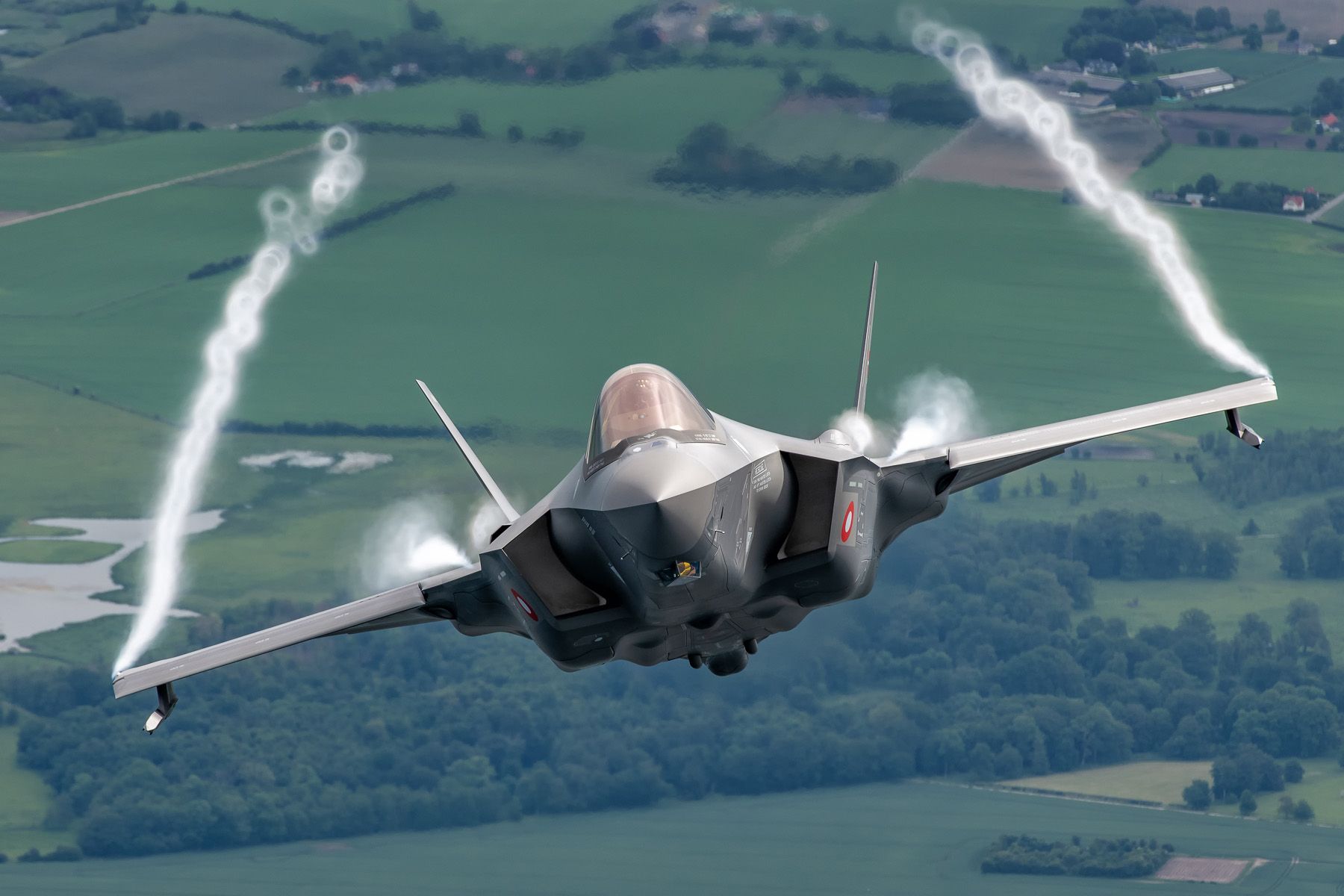
F-16
Denmark still has 43 airworthy F-16s at its disposal, a handful in the older Block 10 variant. All of these will be sold or donated in the upcoming years. More on that later; first, let’s have a look on how this aircraft entered service well over 40 years ago.
In the 1970s, the United States was looking for a new light-weight multi-role fighter aircraft, a competition won by General Dynamics with their YF-16. The resulting F-16A Fighting Falcon (later unofficially dubbed Viper) was subsequently also selected by four European nations to replace their older aircraft like the F-104 Starfighter. Together with the Netherlands, Belgium and Norway, Denmark formed the European Participation Group that signed up for 348 aircraft during the Paris Airshow on 7 June 1975. Of these, 58 were destined for Denmark. The SABCA production line at Gosselies, Belgium would assemble the Danish aircraft, along with those for Belgium. The first Danish F-16 delivered was a two-seater serialled ET-204 on 17 January 1980, soon followed by the first F-16A (E-174) on 15 February.
The first squadrons to be equipped with these aircraft were Eskadrille 727 and 730 respectively, both based at Skrydstrup in the fighter-bomber role. Their last vintage North American F-100 Super Sabres were withdrawn from service in 1982.
Next units to receive F-16s were Eskadrille 723 and 726 both at Aalborg in northern Jutland. Being pure air defence squadrons, the arrival of the F-16s allowed the retirement of the last F-104G and CF-104 Starfighters by 1986.
As only 58 aircraft for four squadrons proved to be insufficient – minus a few that had to be written off following accidents – a follow-up order for another 12 aircraft was placed. Since the production line in Belgium had closed for business in the meantime, these aircraft – eight F-16A and four F-16B Block 15 – rolled off the Fokker assembly line at Schiphol, the Netherlands and were delivered between late 1987 and late 1989.
To compensate further for possible future losses, Denmark turned to the United States in the 1990s to check out the availability of additional aircraft. Since production of the A and B models had been ceased by now, only used airframes were available. Between 1994 and 1997, Denmark took over six Block 15 F-16As and one Block 10 F-16B from the US Air Force after a thorough refurbishment.
Let’s go back to 1989, when a two-year study commenced regarding possible mid-life upgrades for F-16s of both the USAF and the European Partner Air Forces (EPAF) Block 15 F-16A/Bs. The resulting Mid-Life Update (MLU) package was designed to upgrade both cockpit and avionics similar to the F-16C/D Block 50/52. It also added the ability to employ radar-guided air-to-air missiles like the AIM-120 AMRAAM. Furthermore, a modular mission computer with faster data processing was added as well as an advanced IFF system, and the installation of the APG-66(V)2A radar with increased range allowed the ability to track and engage more targets than with the old system.
MLU development started in May 1991 and the first of five testbeds flew on 28 April 1995. Meanwhile, the USAF had dropped from the project, but the European nations continued all the way until the development phase was completed in 1997. Of the 70 aircraft originally delivered to Denmark, 60 were upgraded, now referred to as F-16AM/BM. Also all six former USAF F-16As that were taken on charge a few years earlier received the MLU update.
Like many western air arms, the Royal Danish Air Force would soon become subject of various cuts due to decreasing defence budgets. First victim would be the Aalborg-based Eskadrille 723. Although being the lead-in squadron for the F-16 MLU from 1997, the unit was disbanded on 8 January 2001. Personnel and equipment moved to sister unit Eskadrille 726, but a new round of reorganisations would seal the fate on this squadron too. A decision was made to concentrate all F-16 operations within the Fighter Wing Skrydstrup, that was established on 1 January 2006. By the end of 2005, the curtain fell at Aalborg for fighter operations, and their aircraft were divided between Fighter Squadrons 727 and 730, as these units were now referred to as such. Meanwhile, some of the older Block 10 airframes were withdrawn from service.
With the expected arrival of the F-35, Fighter Squadron 730 was deactivated on 1 January 2020, its buildings making way for the new to be constructed F-35 campus. With this move, all F-16 operations, ranging from pilot conversion to the QRA task, are now concentrated within Fighter Squadron 727.
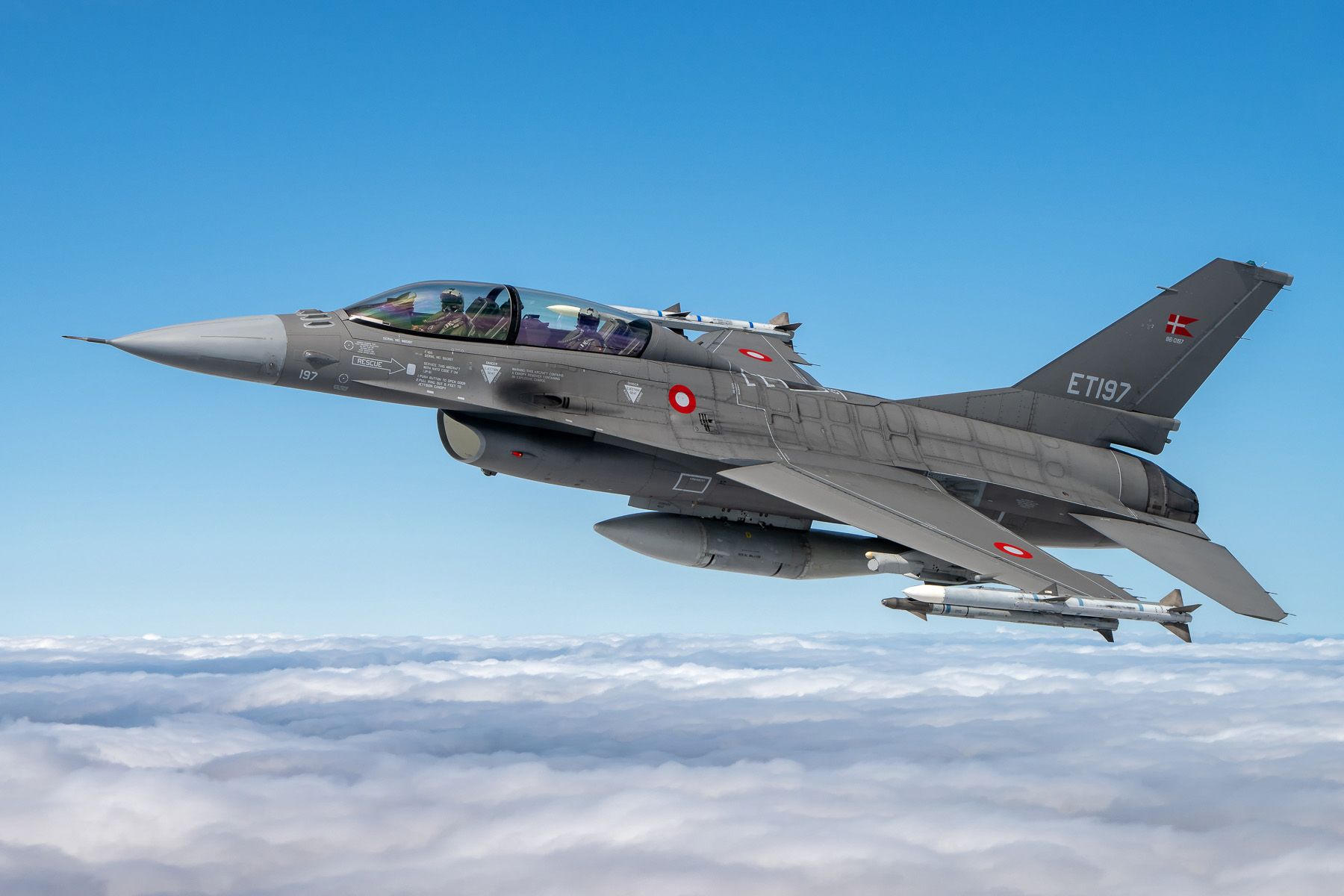
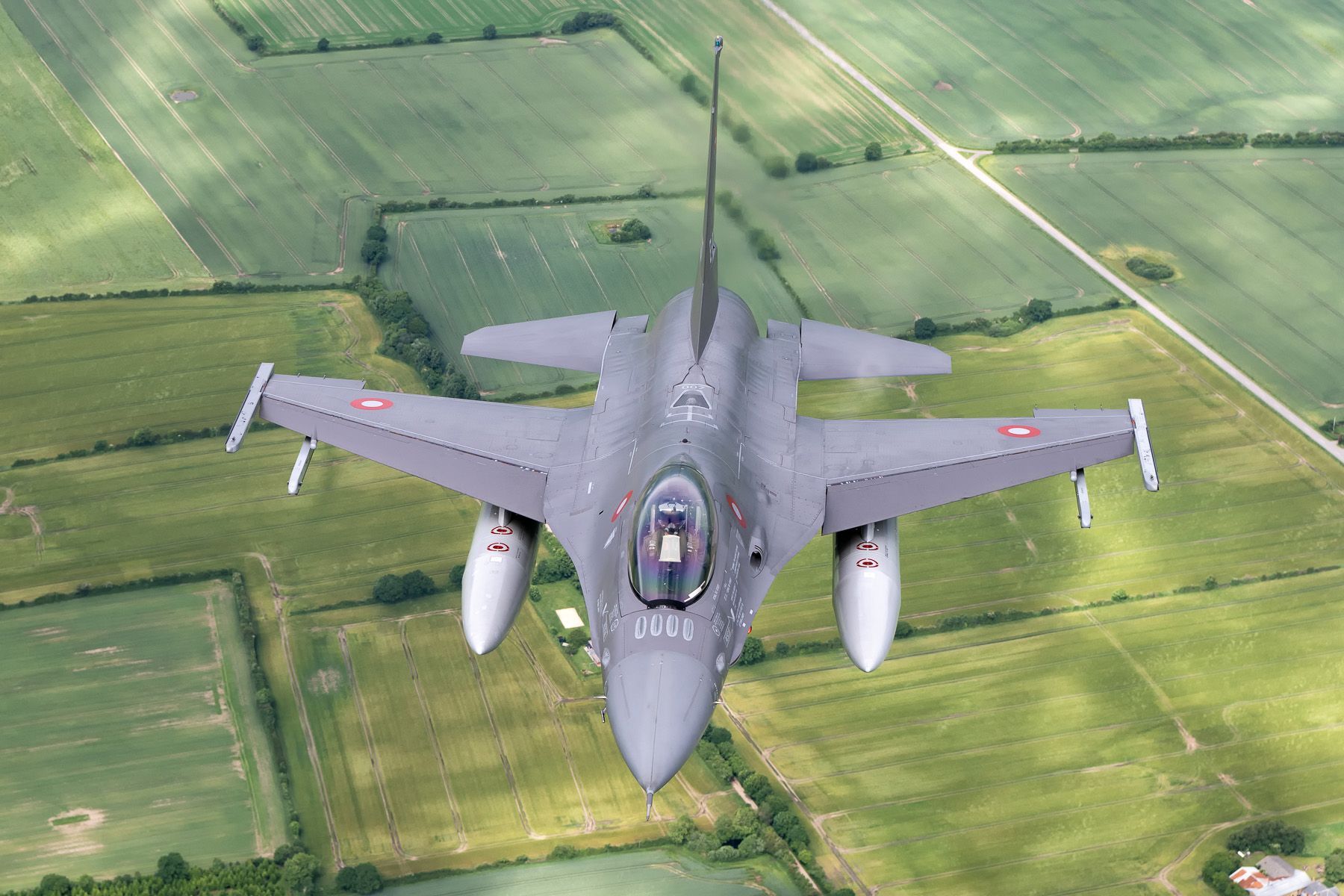
A new paint scheme, known as Have Glass V, was applied to F-16AM E-005 at Aalborg, where the heavy maintenance visits are carried out. It was delivered with its new livery on 22 September 2020, and by mid 2024, some dozen aircraft have received this scheme. The big advantage of it is the significantly reduced radar cross section (RCS). The paint shop in Aalborg also delivered the two ‘Dannebrog’ aircraft in attractive Danish Flag outfits. F-16AM E-191 carried this paint scheme between 15 June 2019 and 12 October 2023, while F-16AM E-006 became the new version, unveiled on 6 June 2024. The aircraft is used by the RDAF F-16 Solo Display Team, currently piloted by ‘TEO’.
And so, the F-16 would move on to an uneventful retirement. Until the 2022 Russian invasion into Ukraine would stir up this timeline. After long hesitations, NATO decided to donate a number of F-16s of various members to Ukraine, but this would obviously mean a thorough training for their pilots. Many articles have been published on this topic, here we’ll just highlight the Danish effort within the scope of this article on the Fighter Wing Skrydstrup.
To train Ukrainian pilots to safely and effectively operate the F-16, a training centre was established at Skrydstrup, making use of Danish assets. To assist, both the Norwegian and Belgian air forces have temporarily added a few aircraft. Two Norwegian F-16BM dual-seaters arrived early 2024, followed by a single F-16AM. A remarkable effort, since Norway already phased out their F-16s a number of years ago. Furthermore, two Belgian F-16BMs were made available.
Training pilots is not the only contribution. During a trip to Denmark including a short visit to Skrydstrup by Ukrainian president Zelensky in August 2023, the donation of 19 F-16s was confirmed.
The offer will leave Denmark with 24 F-16s: exactly this amount was part of a deal with Argentina, that was announced on 27 March 2024 by Minister of Defence Troels Lund Poulsen. The contract worth DKK 2.1 billion (EUR 280 million) was signed on 16 April 2024, and consists of 16 F-16AM Block 15, eight F-16BM Block 15, and a single F-16AM Block 10 to service as ground instructional airframe. The F-16s are planned to be operated by Grupo Aéreo 6 de Caza at Tandil. After 50 years of service, Argentina will then become the next F-16 operator on an extensive list of operators worldwide, quite a remarkable achievement.
The last flight of an F-16 with the Flyvevåpnet will not be before a few more years however, and will of course be dependent on the moment the F-35 will have become fully operational.
F-16 serials overview
SABCA-built:
- E-174/203 F-16A c/n 6F-1/30 FMS 78-0174/0203
- ET-204/211 F-16B c/n 6G-1/8 FMS 78-0204/0211
- E-596/611 F-16A c/n 6F-31/46 FMS 80-3596/0611
- ET-612/615 F-16B c/n6G-9/12 FMS 80-3612/3615
Fokker-built:
- E-004/008 F-16A c/n 6F-47/51 FMS 87-0004/0008
- E-016/018 F-16A c/n 6F-52/54 FMS 88-0016/0018
- ET-197/199 F-16B c/n 6G-13/15 FMS 86-0197/0199
- ET-022 F-16B c/n 6G-16 FMS 87-0022
Former USAF aircraft:
- E-011 F-16A c/n M12-4 ex USAF 82-1011 (c/n 61-604)
- E-024 F-16A c/n M12-1 ex USAF 82-1024 (c/n 61-617)
- E-070 F-16A c/n M12-5 ex USAF 83-1070 (c/n 61-623)
- E-074 F-16A c/n M12-6 ex USAF 83-1074 (c/n 61-627)
- E-075 F-16A c/n M12-2 ex USAF 83-1075 (c/n 61-628)
- E-107 F-16A c/n M12-3 ex USAF 83-1107 (c/n 61-670)
- ET-626 F-16B c/n M16-1 ex USAF 80-0626 (c/n 62-68)
Most of these were upgraded to F-16AM/BM except for F-16As E-175, 178, 179, 185, 186 & 201 as well as F-16Bs ET-205, 209 & 211, as these were previously written off following accidents. Also, both F-16A E-183 and F-16B ET-626 were not converted and withdrawn from service.
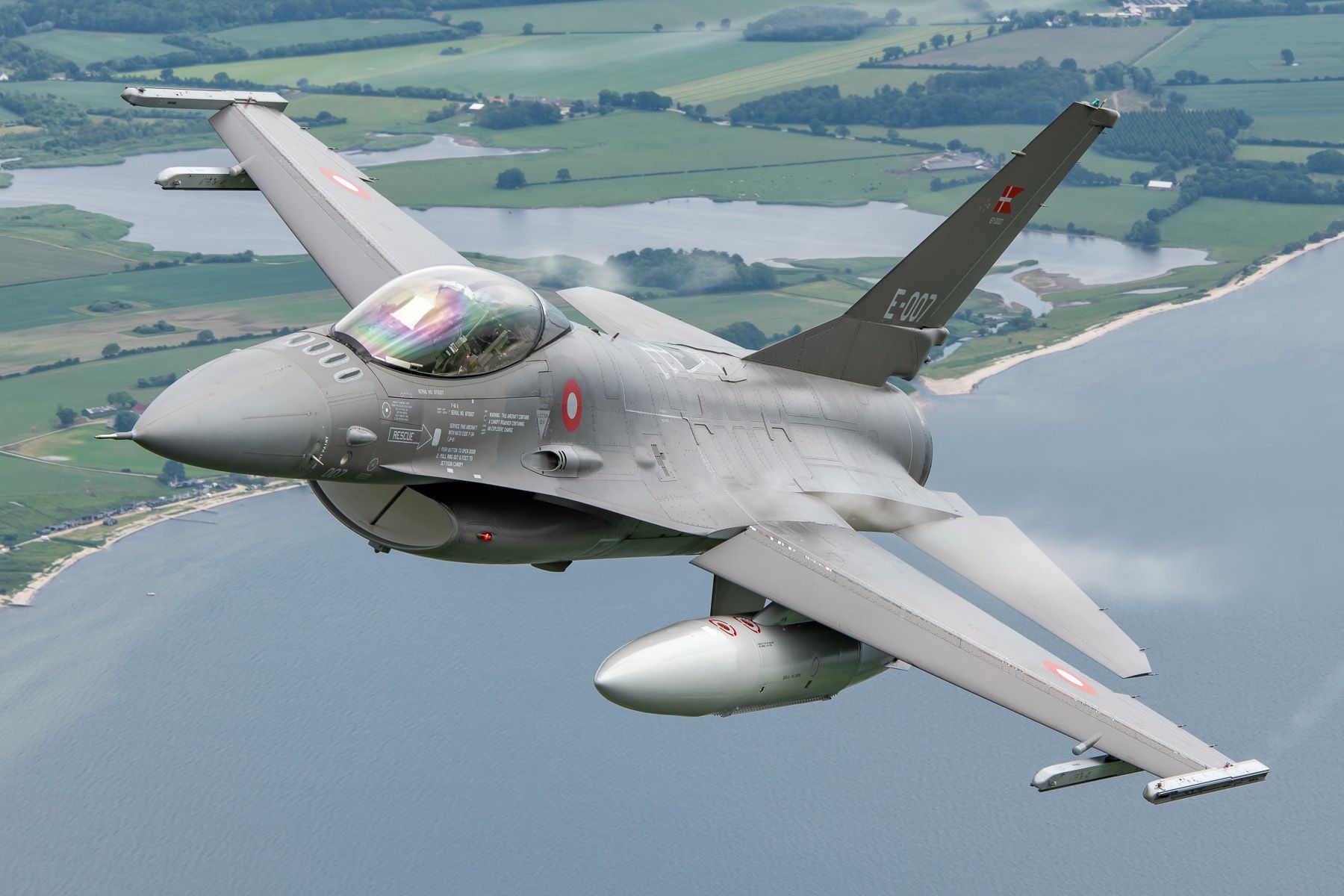
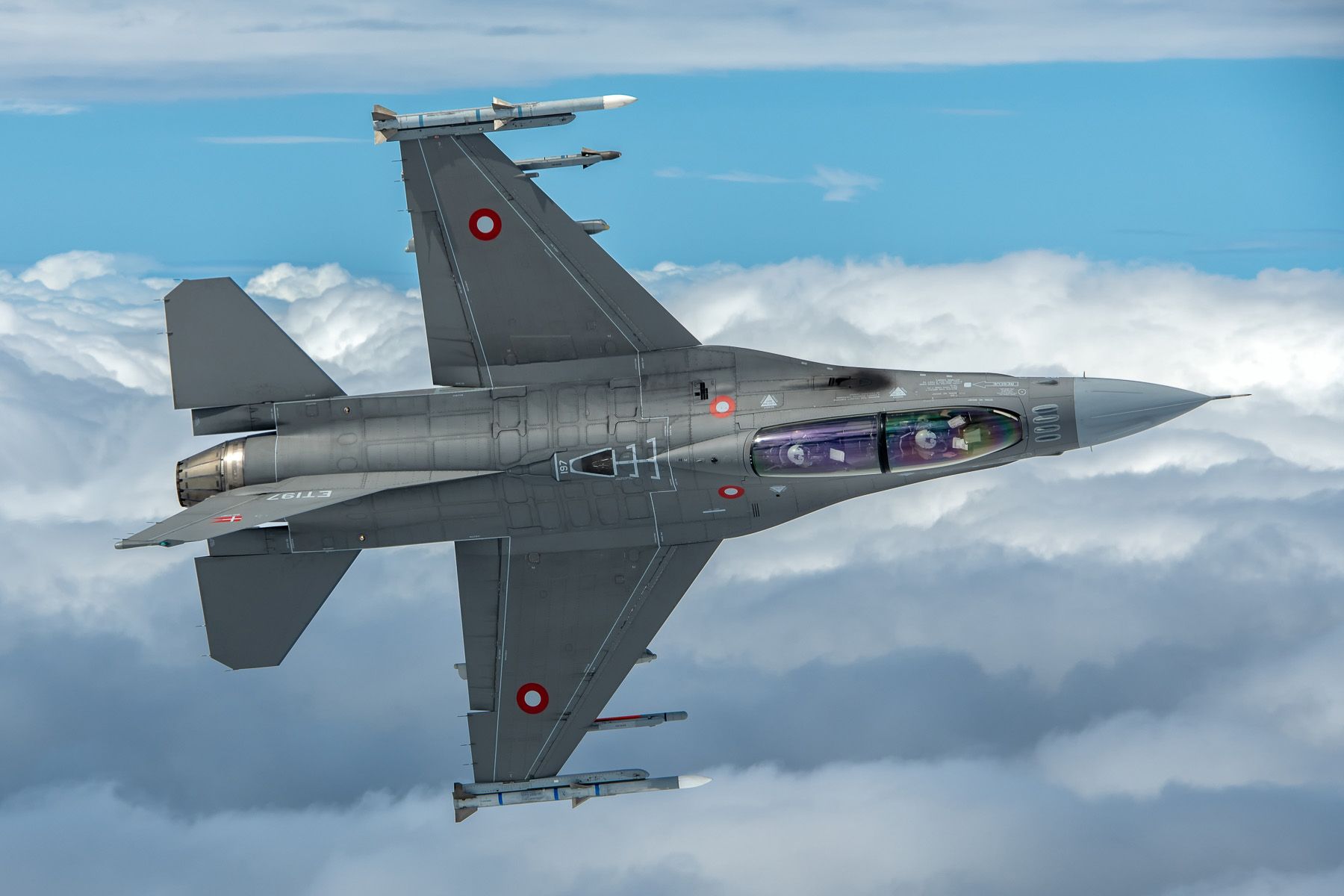
FWSKR and its Fighter Squadrons
Currently, Fighter Wing Skrydstrup consists of a single squadron, being Fighter Squadron 727. To separate the operations with their two different types of aircraft, the unit is temporarily divided into Fighter Squadron 727-16 and 727-35, referring to their equipment.
Eskadrille 727 was formed at Karup on 1 November 1952. That particular base was the birthplace of all eight RDAF fighter squadrons (723 to 730) in the first half of the 1950s. The Flyvevåpnet itself was not established until 1 October 1950; military flying operations were previously carried out by branches of the Danish army and navy.
Eskadrille 727 was equipped with the Republic F-84 Thunderjet. Following six F-84Es, a staggering total of 238 F-84Gs were supplied by the United States as military aid under the Mutual Assistance Program (MAP), partly former Netherlands and Belgian air force examples. Beside Eskadrille 727, Thunderjets would operate with five other Danish squadrons.
The Thunderjets had a rather poor safety record partly due to the inexperience of its pilots but also due to the kind of operations, being mainly low-level. In 1959 these were disposed of by Eskadrille 727 and the unit would enter the supersonic age with the arrival of their first three North American F-100 Super Sabres on 16 May 1959. Within a few months, 727 was equipped with a total of 17 F-100Ds and three two-seat F-100Fs. Like the Thunderjets, these aircraft were supplied in view of the MAP programme. And so, the Royal Danish Air Force received 48 F-100Ds and ten F-100Fs, allowing two more squadrons to convert to the Super Sabre. By 1961, the last Thunderjets retired from Danish service.
Although not as dramatic compared to their predecessor, also the Super Sabre operation was prone to accidents. Because of this, and due to restructuring of pilot training, it was necessary to acquire more aircraft as by the end of 1966 only 41 aircraft remained; just sufficient for two squadrons. From 1970, F-100 unit Eskadrille 725 at Karup would receive the Saab F-35XD Draken, allowing their Super Sabres to be reassigned to Eskadrilles 727 and 730, which brought some relief. Nevertheless, the RDAF received 14 used two-seat F-100Fs in 1974 that had been purchased second-hand from the USAF. These were designated TF-100F as they differed slightly from the F-100Fs already in service.
On 1 April 1974, Eskadrille 727 moved to its present home base Skrydstrup. To prepare for the arrival of the General Dynamics F-16 for which Eskadrille 727 was appointed as the first operator, the squadron was divided into two separate flights on 1 July 1979. While one would receive the new F-16s, the other continued to operate the F-100 until these were put aside in 1981.
Eskadrille 727 reached operational status with their new equipment in 1980. The squadron would also become the type’s dedicated operational conversion unit within the Royal Danish Air Force.
While initially serving as a fighter bomber squadron (alongside its pilot conversion task), both Eskadrille 727 and its sister squadron 730 became multi-role squadrons in 2003, as the Aalborg-based air defence squadrons were disbanded. On 1 January 2005, the unit’s designation was changed into Fighter Squadron 727. A new structure within the Flyvevåpnet was introduced on 1 January 2006, in which the base was renamed into Fighter Wing Skrydstrup. This would also become the parent unit of both Eskadrille 727 and 730.
A recent milestone was the arrival of the first four Lockheed Martin F-35A Lightning IIs on 14 September 2023. Fighter Squadron 727 was confirmed to be the sole operator of this new aircraft. During a transitional period, 727 will operate both the F-16 and the F-35. Therefore it consists of a 727-16 squadron and 727-35 squadron, quite similar as when the F-16 was introduced.
Although Fighter Squadron 730 is now no longer active, its deactivation occurred quite recently so we’ll mention its history here also.
Eskadrille 730 was established on 1 January 1954 at Karup and like most fighter squadrons it was to fly F-84 Thunderjets. Later that year, on 6 September, it moved from Karup to Skrydstrup, but it temporarily relocated to Karup on 16 March 1959, where it retired its Thunderjets soon after. Like Eskadrille 727, it converted to the F-100D/F Super Sabre and with these new supersonic aircraft, the squadron returned to Skrydstrup on 20 September 1961.
On 11 August 1981, the first F-16 arrived with the squadron and it became fully operational with these aircraft in 1982. The last Super Sabres were disposed of in that same year. Of the remaining examples, 21 F-100Ds and two F-100Fs transferred to the Turkish air force, while six TF-100Fs were sold to a civilian company to tow aerial targets.
Later that decade, Eskadrille 730 became the first Danish air force unit to become part of the High Readiness Force (HRF). While initially serving as fighter bomber squadrons, both 727 and 730 became multi-role squadrons in 2003, following the decision to deactivate the Aalborg-based air defence squadrons that also operated the F-16.
On 1 January 2005, the unit’s designation was changed into Fighter Squadron 730. The air force switched to an Expeditionary Air Force organisation on 1 January 2006, and while the last Aalborg-based F-16 squadron (Eskadrille 726) disbanded on 31 December 2005, the operational pilots of the latter joined Fighter Squadron 730. Fun fact: the squadron’s call sign was ‘Birdsong’, referring to the Fuglsang brewery located in nearby Haderslev.
With the choice of Fighter Squadron 727 to become the F-35 unit, this meant a farewell to Fighter Squadron 730, which already was in a dormant state since 1 January 2020.
However, the spirit and experiences from 730 will live on, as the F-35 aircraft operate from the state-of-the-art F-35 Campus, that was being built in the same area where 730's buildings were located.
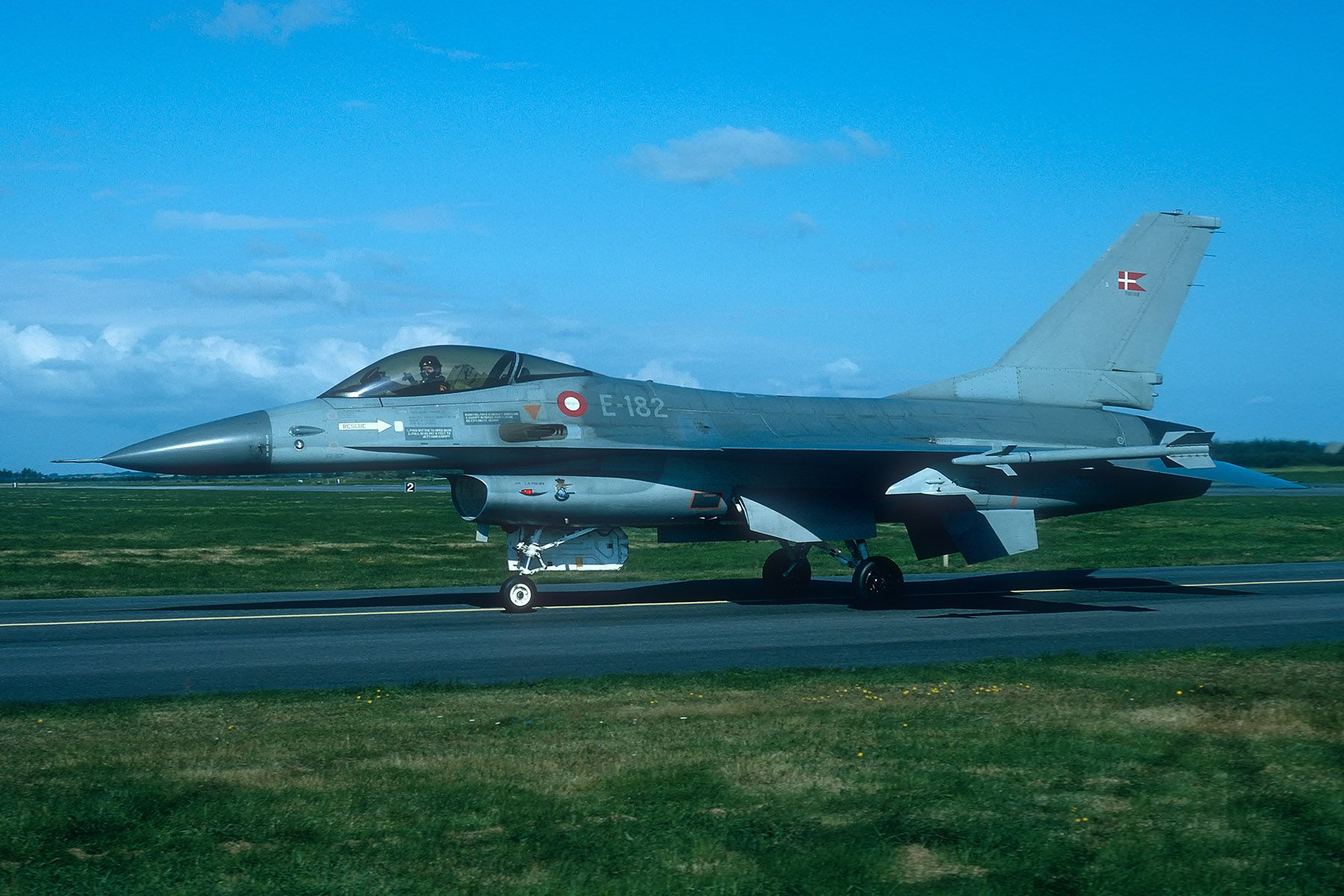
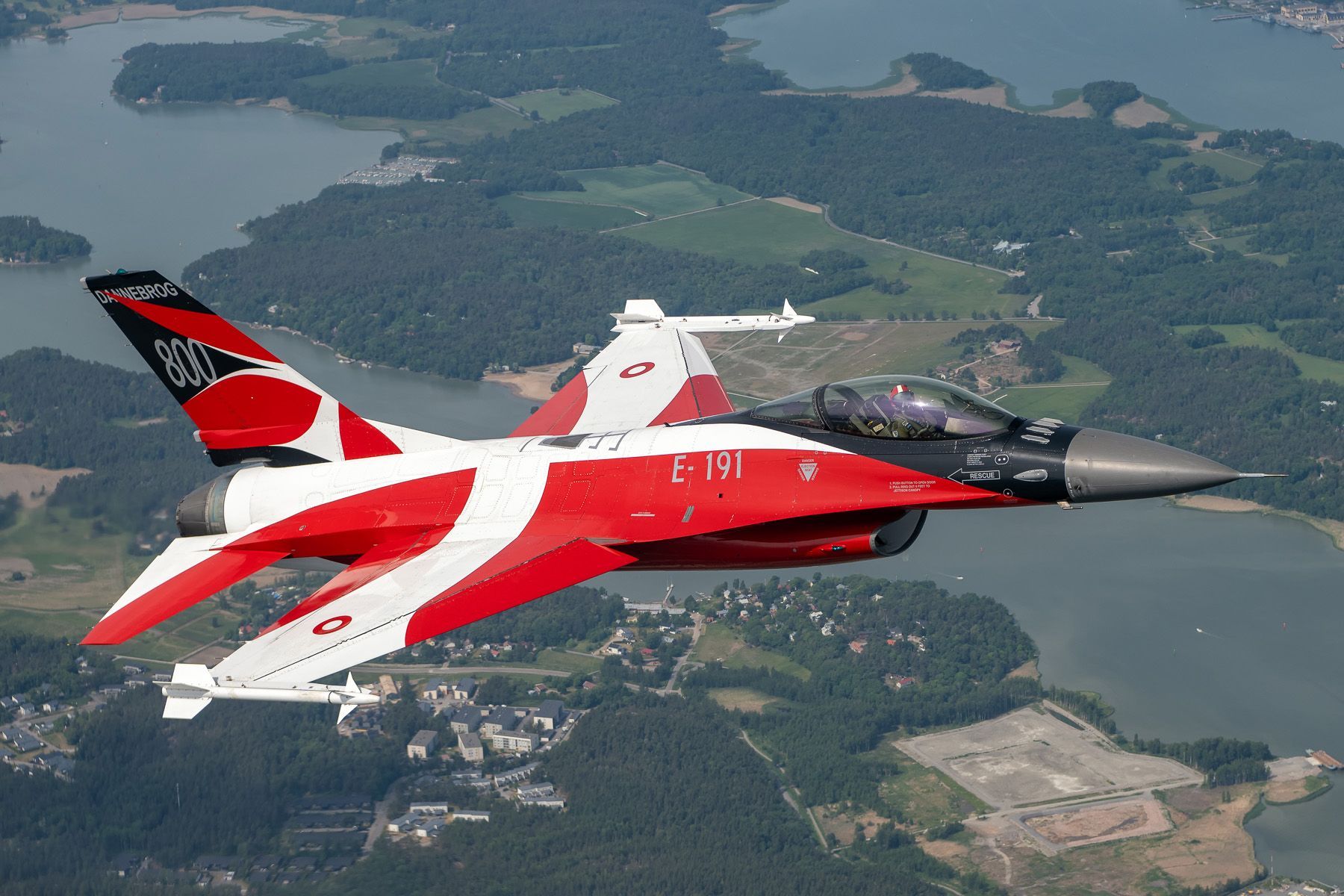
Operations abroad
Since 1999, Danish F-16s have been involved in a number of international operations. Let’s have a look at these, listed below.
- Operation Allied Force (Kosovo)
By NATO’s request, the Danish Parliament decided in October 1998 to provide six F-16s along with pilots and personnel from Eskadrille 730 to an international air force in the Balkans as part of Operation Allied Force. On 13 October 1998, the detachment deployed to Grazzanise, Italy that also hosted the Norwegian contingent.
Air operations against Serbian positions in Kosovo started on 24 March 1999. Following a renewed request from NATO, the Danish Parliament decided to send three more F-16s to Grazzanise in April 1999. These aircraft arrived at Grazzanise three days later.
The majority of Danish air operations comprised air defence and escort missions. Only in the last phase of the operation, Danish F-16s participated in a number of offensive operations, aimed to destroy targets such as radar installations, fuel depots and command centres in Kosovo. On 10 June 1999, Serbia accepted NATO’s peace terms and airstrikes ceased. Soon after, part of the detachment returned home while three F-16s stayed behind in support of the mission to guarantee the peace agreement was not violated. In June 2000, these aircraft were withdrawn as well. Operation Allied Force would be the first time Danish pilots took part in hostilities.
- Operation Enduring Freedom (Afghanistan)
On 7 October 2001, a few weeks after the 9/11 attacks, a US-led coalition launched Operation Enduring Freedom against the Al-Qaeda terrorist network and the Taliban regime in Afghanistan.
To support this effort, Denmark contributed by sending six F-16s to be based at Manas, Kyrgyzstan, in close cooperation with EPAF-partners Norway and the Netherlands. This base was located over 1,000km northeast of the mission area in Afghanistan, resulting in missions that were often up to seven hours long, with in-flight refuelling necessary. Primary task was to fly armed patrols over Afghanistan and, if necessary, provide air support to allied troops on the ground.
In support of Operation Enduring Freedom, the Danish F-16 force flew 743 missions in Afghan airspace, covering some 4,350 flight hours. The Danish detachment ran from 1 October 2002 till 1 October 2003.
- Operation Unified Protector (Libya)
In April 2011, the Danish government decided to send six F-16s from Fighter Wing Skrydstrup to the Mediterranean area, based at Sigonella at Sicily, Italy. Here, at the request of the United Nations, they had to help protect the civilian population in Libya during the civil war. It was the beginning of probably the most operative and intense deployment of the RDAF ever. Within 24 hours, aircraft and personnel were deployed. The conflict ended on 20 October 2011 with the capture and death of Muammar Al-Gaddafi. The Danish contribution returned home early November 2011.
- Operation Inherent Resolve (Iraq & Syria)
In October 2014, a wide majority in the Danish Parliament gave mandate for a further Danish contribution to fight ISIL in Iraq. The military contribution included four F-16 fighter jets, with three more kept in reserve. In 2016, F-16s deployed to Turkey for operations against ISIL in both Iraq and Syria.
- Baltic Air Policing (Baltic States)
Since the Baltic states of Estonia, Latvia and Lithuania that joined NATO on 2 April 2004 all lack adequate air defence assets, NATO has been responsible to defend and police their airspace. NATO member have deployed detachments to this region since 2004, that were mainly operating out of Šiauliai in Lithuania and Ämari in Estonia. Danish F-16s have been frequently present, the first detachment being maintained between 1 July and 14 October 2004 when five aircraft with six pilots were sent over.
- Icelandic Air Policing (Iceland)
Similar to the Baltic Air Policing, NATO secures the skies over Iceland with its very strategic location. From Keflafik, Fighter Wing Skrydstrup has operated during March 2009, March 2010, April 2018 and again in August 2022.
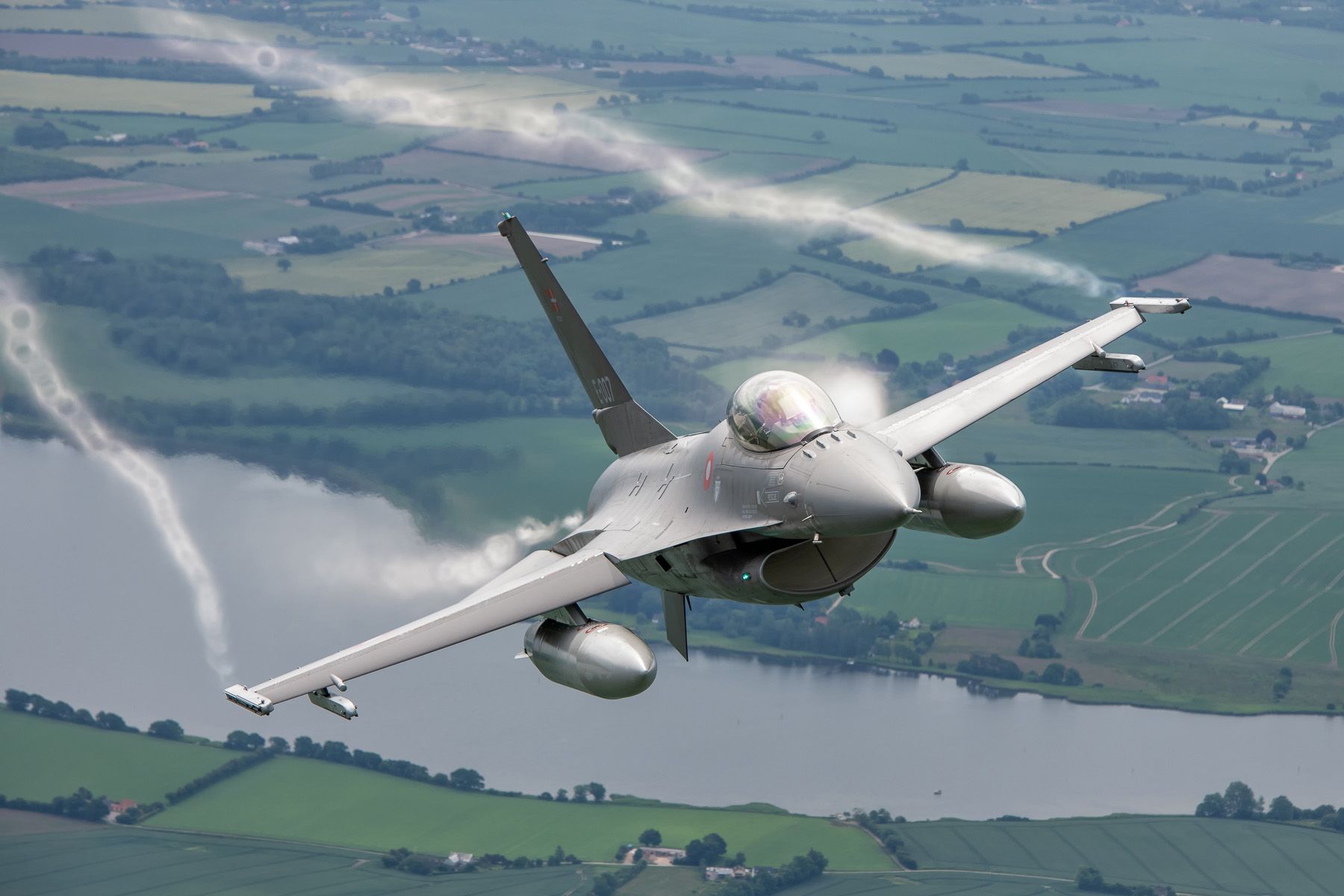
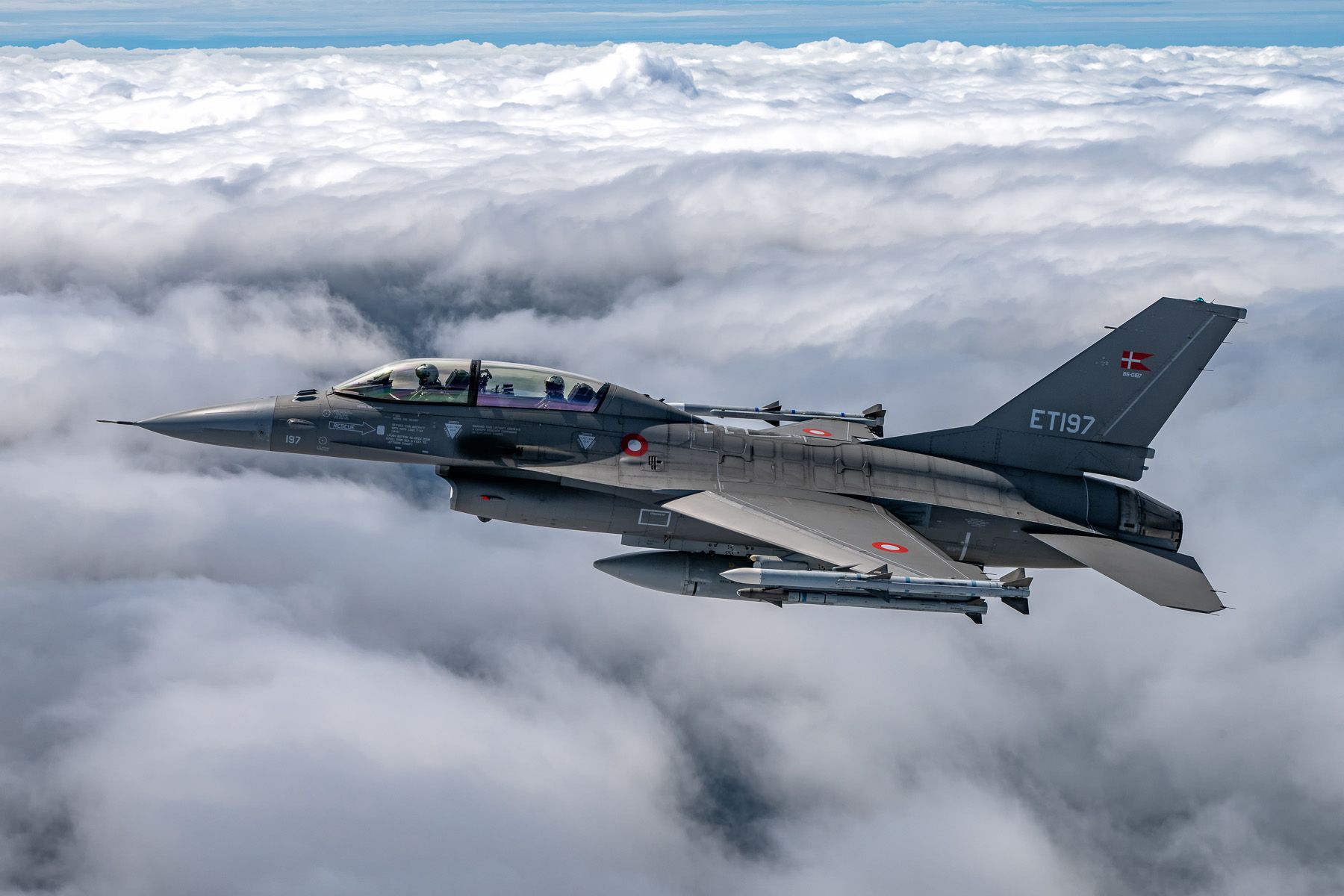
Flyvestation
To finish this article, here is a peek into the history of the base itself.
During WW II the German Luftwaffe constructed the base in 1943. Located some 12km west of the city of Haderslev (yes, that place from the Fuglsang brewery), the base became known as Fliegerhorst Habersleben, the German translation for the village. While planned to house various fighter and bomber planes, this never materialized due to a shortage of aircraft. It would become home to smaller units of amongst others transport and training aircraft until the end of the war, when the Danes turned it into a camp for German refugees.
In 1953, the base was prepared to become an operational location for the Flyvevåpnet that was established a few years before, while the runway was extended to 3,000m. With the arrival of Eskadrille 730 on 6 September 1954, the base entered the jet age.
Besides the mentioned Eskadrilles 727 and 730, two other squadrons have operated from Skrydstrup. Eskadrille 728, another squadron that was activated at Karup as a Thunderjet unit in the 1950s, had relocated to Skrydstrup some time later. In 1960, the unit was the last of three to receive the North American F-86D Sabre all-weather fighter, the other two being Aalborg-based Eskadrilles 723 and 726. Sixty of these aircraft were supplied under the well-known MAP programme. These were initially armed with 24 2.75in Might Mouse FFARs (Folding Fin Aerial Rockets), but the accuracy of these proved to be very poor. A pair of AIM-9B Sidewinder missiles was then added to boost its air defence capability. Noteworthy to mention is that between 1959 and 1964, Danish F-86s deployed several times to Wheelus, a US air base in Libya, for live firing exercises against towed targets because such training areas were not available in Denmark. In 1966, Eskadrille 728 retired their F-86s as the last Danish Sabre unit, and the squadron was disbanded.
The sole Hawker Hunter unit, Eskadrille 724, arrived at Skrydstrup in 1959. Three years earlier, it had received 30 Hunter F Mk.51s to replace their Gloster Meteor F Mk.8s. A pair of T Mk.53 two-seaters followed in 1958 while two additional Hunter T Mk.7s were bought from the Netherlands in 1967. As per Defence Act dated 26 April 1973, it was decided to disband Eskadrille 724. On 30 April 1974, the last Hunter was flown to Aalborg for storage awaiting a possible sale, after which the squadron was deactivated.
Last but not least, we first have to mention that Eskadrille 722 is maintaining a search-and-rescue detachment at Skrydstrup with one EH101 Mk 512 Merlin. The squadron itself is part of the Helicopter Wing Karup but deploys a few helicopters around the country to cover the whole SAR region.
Finally, the local station flight has a few Saab T-17 Supporter light aircraft available for liaison duties. These trainers have been used by the Danes since 1975, and today mainly equip the Karup-based Flyveskolen for Phase 1 elementary pilot training.
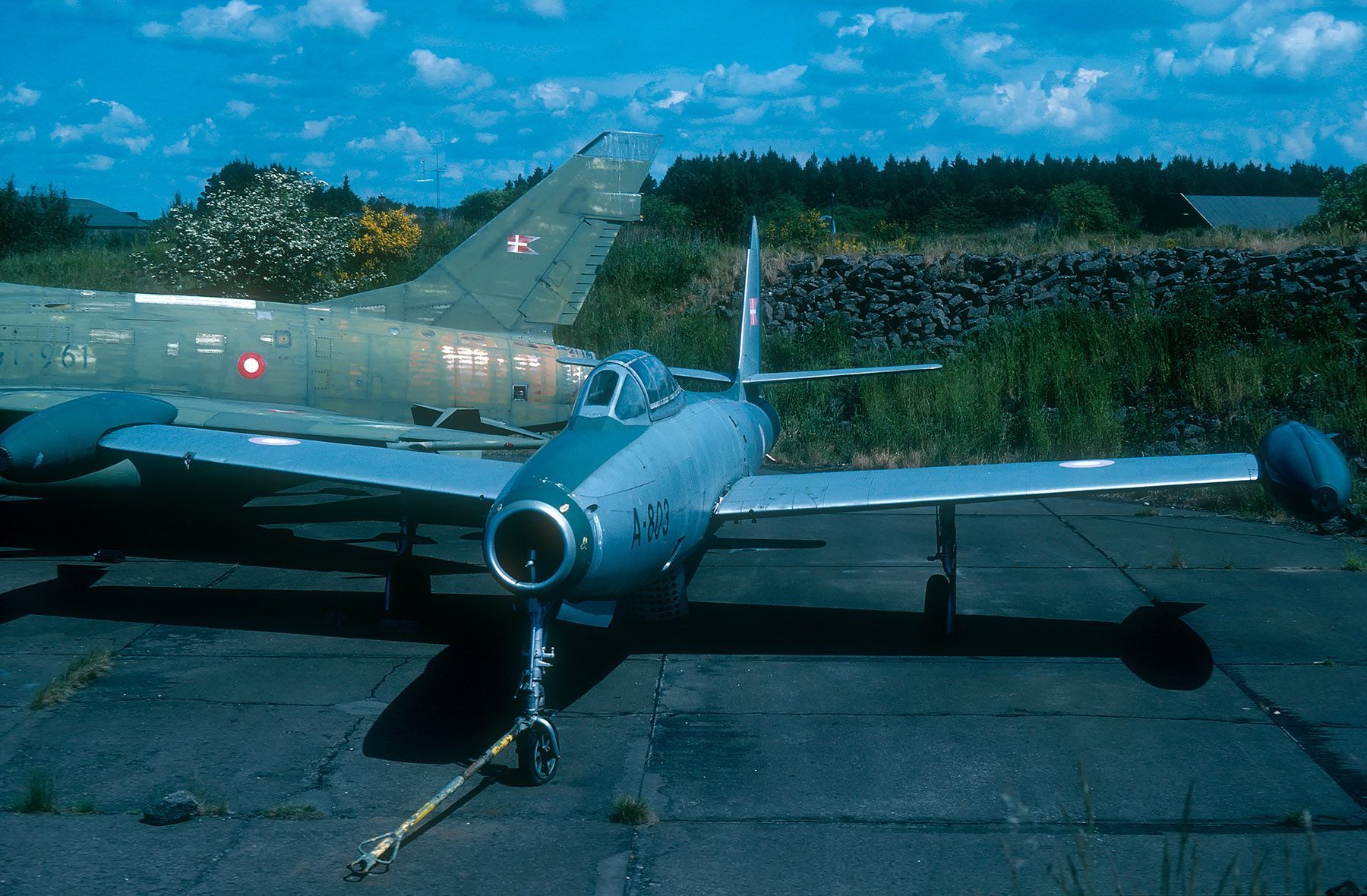
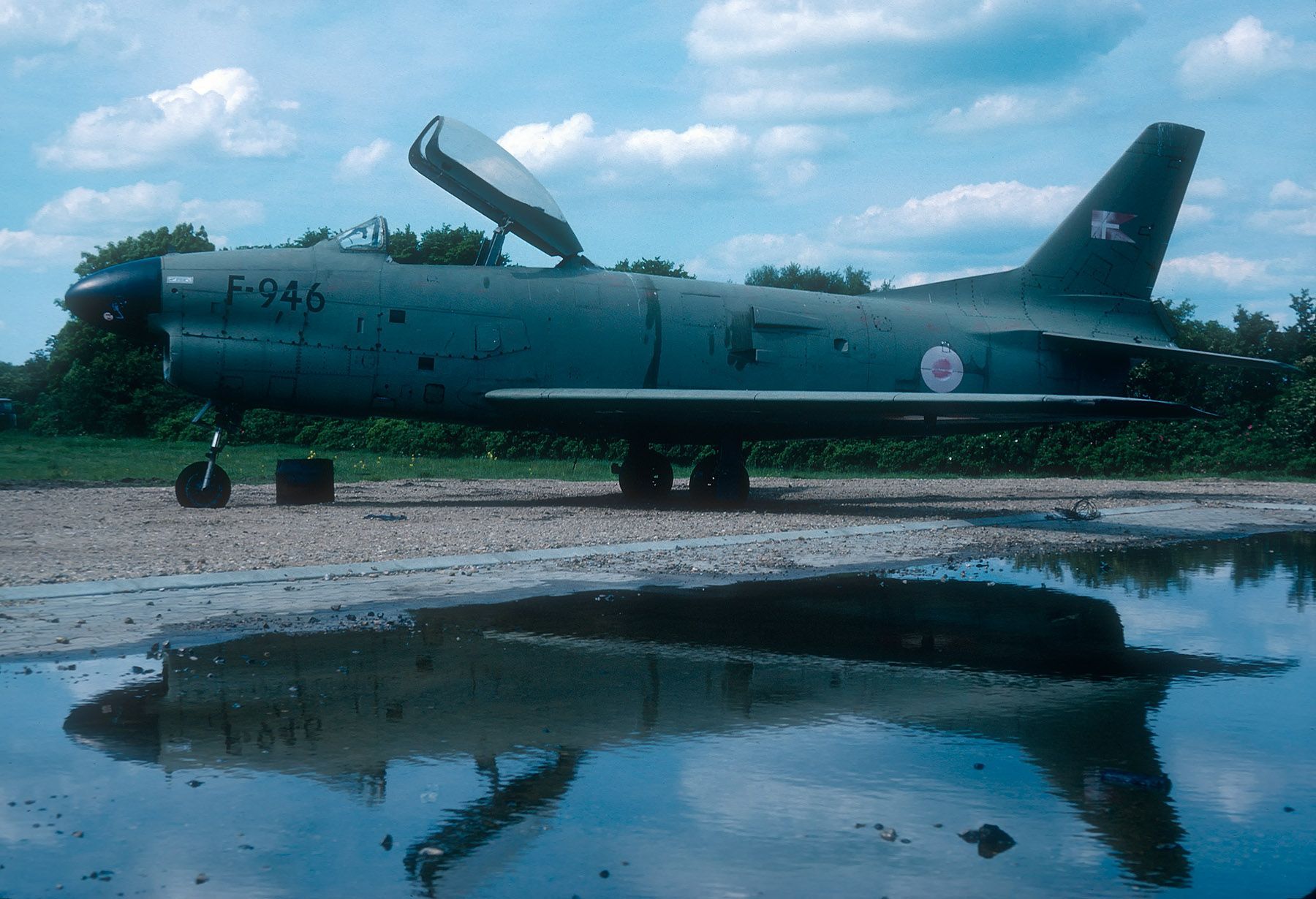
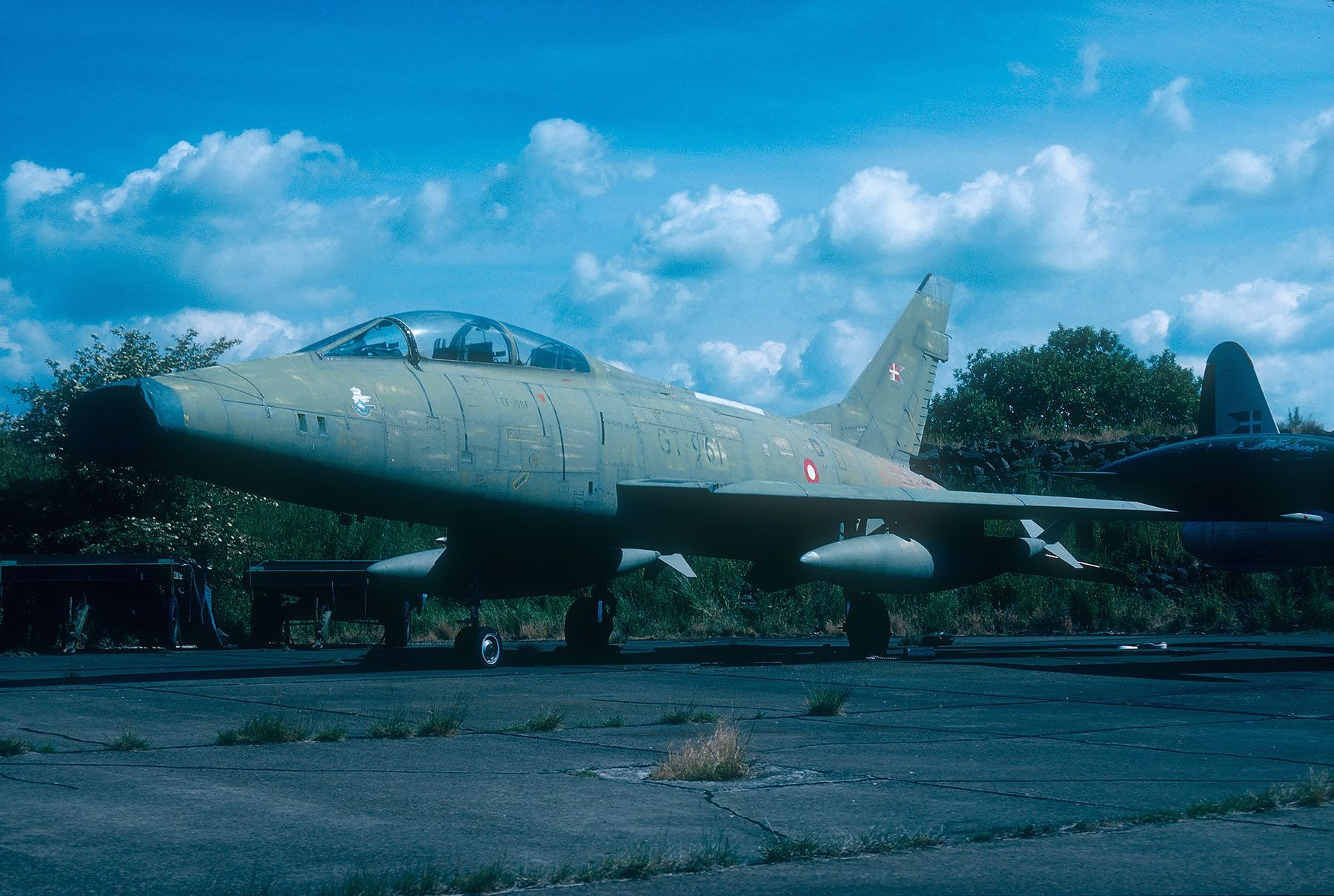
Well, that concludes this piece on the Fighter Wing Skrydstrup. Still want to learn more on the Royal Danish Air Force? A similar article on the Helicopter Wing Karup can be found here! ■
